Disasters Are Inevitable. Being Unprepared Doesn’t Have to Be.
I’m a Michigan native, and if you live in Michigan or have been fortunate enough to spend extended periods of time here, you know that this is a relatively tame state—tame in the sense that we aren’t plagued by annual natural disasters like hurricanes, earthquakes, and tornadoes. Those large and aggressive outbursts that Mother Nature throws out are typically only witnessed from afar. Witnessing rather than experiencing a natural disaster will undoubtedly create a false sense of safety and security that could leave you in a rough situation.
In my opinion, preparedness—much like sports—must be practiced frequently and vigorously. Training to be prepared doesn’t mean you have to turn all your lights off and live in the dark for three days just to know what it will be like. To me, it is a more nuanced expression of planning for the “what ifs.” Putting yourself into a post-disaster scenario mentally can be an incredibly effective tool to help you visualize and develop plans that will allow you to thrive no matter the scenario.
I recently found myself in just such a situation following what turned out to be a once-in-a-generation ice storm that hit Northern Michigan. A large portion of northwest Michigan was hit with an incredibly damaging two-day ice storm that not only destroyed many of the trees and buildings in the area, it left residents without power and gasoline for nearly two weeks.
This was a disaster that was not only a surprise to me because of when it hit—March 30th—but also a reminder of how complacent one can become living in a zone of the country that is often left untouched by situations like this.
How did I respond? By going down a deep, dark rabbit hole of preparedness planning and scenario building in my mind! I started to think about an event-agnostic plan that would carry me through any kind of natural disaster that could come my way. Throughout my mental wargaming, there was a very common thread that kept being pulled… power. Power is one of the core necessities in a grid-down scenario, and it is often one of the first utilities to be impacted.
It just so happens that the first week of May is designated as Hurricane Preparedness Week by the federal government. While I don’t live in a hurricane zone, the impacts of a hurricane could be felt on a much smaller level locally. So, why not plan for the absolute worst-case scenario?
My first order of business was to investigate the most common issues I could face in a prolonged natural disaster to help drive my plans. I built a list of five of the most common issues I could face:
Products like the brand-new Apex 300 can give your preparedness plan a strong backbone to help you endure the most unpredictable weather events, even hurricanes!
![Bluetti Apex 300 Bluetti Apex 300]()
So what does a Michigan Hurricane survival plan entail? For me, it all revolves around staying connected to the internet, keeping my freezers cold, and powering the devices that keep my house livable. I decided that I would build my plan around power and I needed something that was a heavy hitter. I’m not talking about a 500W battery that can charge up a few phones—I need a power station that can do it all. I chose the brand new Apex 300 expandable power station!
The Unpredictability of Disasters: Hurricanes and Beyond
Gaylord’s storm may have been made of ice, but its impact mirrored what coastal communities experience when a hurricane hits. The debris, the outages, the uncertainty—it’s all the same. In both scenarios, the grid is often the first thing to fail. And without power, every modern convenience we rely on quickly falls away.
While hurricanes get more media attention due to their scale, the surprise factor of any storm can be just as disruptive. What connects both events is the immediate need for power: to keep food cold, medical equipment running, phones charged, and internet live. In that sense, regional disasters are united by a shared vulnerability.
That’s why I was excited to get my hands on the new BLUETTI Apex 300. Launching during Hurricane Preparedness Week, this system is more than a portable battery—it’s a full-scale emergency backup system disguised as a plug-and-play unit.
![apex 300 3 apex 300 3]()
The Apex 300 packs a 2,764.8Wh storage capacity as a standalone and delivers up to 3,840W of output. That means it can power major appliances, tools, and even electric vehicles. With dual 120V/240V support, it’s suitable for everything from refrigerators to sump pumps. And because it supports pass-through charging, you can power your devices while topping off the unit with solar, AC, or vehicle input.
Speaking of charging, the Apex 300 supports some mind-blowing speeds when it comes to charging:
![APEX 300 4 APEX 300 4]()
What makes this system even more powerful is that it allows for modular expansion. I paired my Apex 300 with a B300K expansion battery, which adds another 2,764.8Wh to the system. It plugs right in and allows you to easily scale your backup power supply.
![Image]()
![Image]()
Deep Dive: How Am I Going to Use the Apex 300?
My home is already wired with a generator inlet and a whole-house switch, so should I want to, integrating the Apex 300 into that setup will be seamless. I would simply connect the Apex to my home inlet box using the built-in NEMA 14-50R or TT-30R port, flip the switch, and I’m live.
In case you are wondering what a NEMA 14-50R or TT-30R port is, I’ve got you covered!
![Image]()
If you want to run heavy appliances like electric stoves or HVAC systems, you’ll want to run multiple units in parallel or use a transfer switch to isolate essential circuits. The Apex 300 supports up to 50A/12,000W bypass capability and 0ms UPS switchover, which means it can handle sudden outages without a hitch.
App Control and Smart Connectivity
One of the most underrated features of the Apex 300 is its seamless integration with the BLUETTI app. From my phone, I can monitor charge levels, adjust output settings, prioritize power sources, and even enable specific modes like Peak Load Shifting or Extreme Weather Alerts. This level of control is crucial when you’re away from home or managing energy use during an outage. The app also pushes firmware updates over the air, which means the system is always improving with new features and optimizations—no tools or tech support required.
Staying Connected: Pairing with Starlink Mini
Power is one thing, but staying connected is another. That’s where the Starlink Mini comes in. I keep mine as part of my go-kit, and the Apex 300 powers it easily. In a blackout, having satellite internet means I can still reach family, check weather alerts, and get work done.
![Image]()
This combo is especially valuable for remote properties. Whether it’s my northern Michigan lease or a hurricane-prone cabin in the Gulf, a backup system is only complete if it keeps you connected. The Apex 300 delivers that.
The Starlink Mini draws on average 40 watts, which means it could power the device for nearly 70 hours on a single charge. Since I won’t be using the Starlink for 70 hours continuously, I could, in theory, provide myself with short bursts of internet connectivity for weeks on end without ever needing to charge the Apex 300.
Everyday Use: Beyond Emergency Power
While the Apex 300 is built to thrive in extreme conditions, it’s equally at home in everyday life. Whether I’m road-tripping across the Midwest or spending long weekends at a remote hunting camp, this power station has quickly become a staple. It’s quiet, clean, and powerful enough to handle whatever I throw at it—from running a portable fridge and charging my tools to lighting up a remote basecamp after dark.
For travel and off-grid use, having reliable power changes everything. I don’t have to worry about draining my vehicle battery or rationing usage when I’m boondocking or off the beaten path. With solar input and expandable storage, the Apex 300 gives me freedom—freedom to stay longer, go further, and remain connected without compromise.
Conclusion
Whether you’re dealing with ice storms in the north or hurricanes on the coast, the need for reliable backup power is universal—and increasingly urgent. The BLUETTI Apex 300 delivers a flexible, high-output solution that fits the unpredictable nature of modern emergencies. Its rapid charge capabilities, expandability with B300K batteries, and versatility across home, RV, and off-grid setups make it one of the most well-rounded power stations available today.
If you’re ready to take the first step toward true energy independence, BLUETTI is currently letting you secure the Apex 300 for just a $10 pre-order deposit on their website. This is an investment that could make a massive difference the next time disaster strikes. Don’t wait for the power to go out—get ahead of it with the Apex 300.
I’m a Michigan native, and if you live in Michigan or have been fortunate enough to spend extended periods of time here, you know that this is a relatively tame state—tame in the sense that we aren’t plagued by annual natural disasters like hurricanes, earthquakes, and tornadoes. Those large and aggressive outbursts that Mother Nature throws out are typically only witnessed from afar. Witnessing rather than experiencing a natural disaster will undoubtedly create a false sense of safety and security that could leave you in a rough situation.
In my opinion, preparedness—much like sports—must be practiced frequently and vigorously. Training to be prepared doesn’t mean you have to turn all your lights off and live in the dark for three days just to know what it will be like. To me, it is a more nuanced expression of planning for the “what ifs.” Putting yourself into a post-disaster scenario mentally can be an incredibly effective tool to help you visualize and develop plans that will allow you to thrive no matter the scenario.
I recently found myself in just such a situation following what turned out to be a once-in-a-generation ice storm that hit Northern Michigan. A large portion of northwest Michigan was hit with an incredibly damaging two-day ice storm that not only destroyed many of the trees and buildings in the area, it left residents without power and gasoline for nearly two weeks.
This was a disaster that was not only a surprise to me because of when it hit—March 30th—but also a reminder of how complacent one can become living in a zone of the country that is often left untouched by situations like this.
How did I respond? By going down a deep, dark rabbit hole of preparedness planning and scenario building in my mind! I started to think about an event-agnostic plan that would carry me through any kind of natural disaster that could come my way. Throughout my mental wargaming, there was a very common thread that kept being pulled… power. Power is one of the core necessities in a grid-down scenario, and it is often one of the first utilities to be impacted.
It just so happens that the first week of May is designated as Hurricane Preparedness Week by the federal government. While I don’t live in a hurricane zone, the impacts of a hurricane could be felt on a much smaller level locally. So, why not plan for the absolute worst-case scenario?
My first order of business was to investigate the most common issues I could face in a prolonged natural disaster to help drive my plans. I built a list of five of the most common issues I could face:
- Extended Power Outages – Often the first system to fail, leaving homes without heating, cooling, refrigeration, or communication.
- Blocked or Impassable Roads – Debris, downed trees, or flooding can isolate neighborhoods and delay emergency response.
- Communication Blackouts – Cell towers and internet service often go down, making it hard to reach help or stay informed.
- Spoiled Food and Medication – Lack of refrigeration leads to food spoilage and potentially life-threatening issues for those with temperature-sensitive medications.
- Medical Emergencies Without Support – Power-dependent medical devices like CPAPs, oxygen concentrators, or refrigerated insulin storage become unusable without backup power.
Products like the brand-new Apex 300 can give your preparedness plan a strong backbone to help you endure the most unpredictable weather events, even hurricanes!
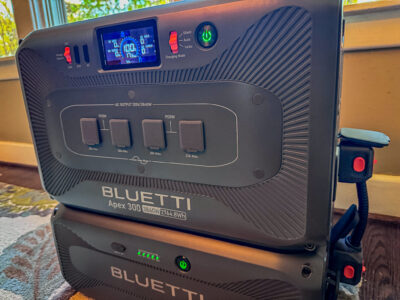
So what does a Michigan Hurricane survival plan entail? For me, it all revolves around staying connected to the internet, keeping my freezers cold, and powering the devices that keep my house livable. I decided that I would build my plan around power and I needed something that was a heavy hitter. I’m not talking about a 500W battery that can charge up a few phones—I need a power station that can do it all. I chose the brand new Apex 300 expandable power station!
The Unpredictability of Disasters: Hurricanes and Beyond
Gaylord’s storm may have been made of ice, but its impact mirrored what coastal communities experience when a hurricane hits. The debris, the outages, the uncertainty—it’s all the same. In both scenarios, the grid is often the first thing to fail. And without power, every modern convenience we rely on quickly falls away.
While hurricanes get more media attention due to their scale, the surprise factor of any storm can be just as disruptive. What connects both events is the immediate need for power: to keep food cold, medical equipment running, phones charged, and internet live. In that sense, regional disasters are united by a shared vulnerability.
That’s why I was excited to get my hands on the new BLUETTI Apex 300. Launching during Hurricane Preparedness Week, this system is more than a portable battery—it’s a full-scale emergency backup system disguised as a plug-and-play unit.
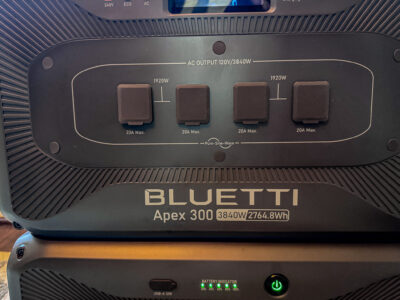
The Apex 300 packs a 2,764.8Wh storage capacity as a standalone and delivers up to 3,840W of output. That means it can power major appliances, tools, and even electric vehicles. With dual 120V/240V support, it’s suitable for everything from refrigerators to sump pumps. And because it supports pass-through charging, you can power your devices while topping off the unit with solar, AC, or vehicle input.
Speaking of charging, the Apex 300 supports some mind-blowing speeds when it comes to charging:
- AC Charging – Reaches 100% in just 65 minutes using standard wall power. My mind was blown with this one.
- Solar Charging – Each unit supports up to 2,400W input via dual MPPT controllers, reaching 80% in just 40 minutes under optimal conditions.
- Parallel Solar Charging – With three units in parallel, you can hit a staggering 30,720W of solar input, forming the world’s largest portable solar microgrid.
- Car Charging (DC to DC Alternator) – Up to 560W of fast charging using your vehicle’s alternator while on the move.
- Generator Input – Compatible with gas or dual-fuel generators for off-grid recovery during extended outages.
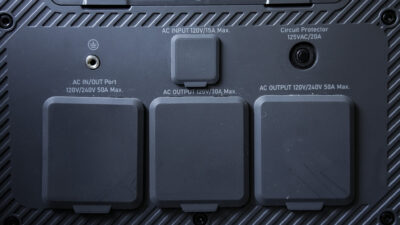
What makes this system even more powerful is that it allows for modular expansion. I paired my Apex 300 with a B300K expansion battery, which adds another 2,764.8Wh to the system. It plugs right in and allows you to easily scale your backup power supply.
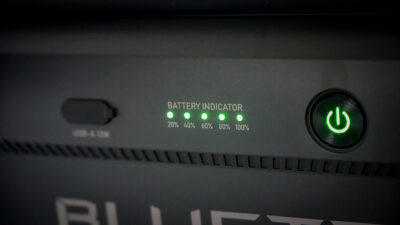
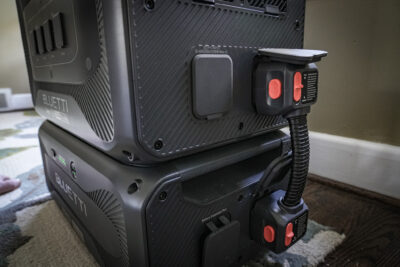
Deep Dive: How Am I Going to Use the Apex 300?
My home is already wired with a generator inlet and a whole-house switch, so should I want to, integrating the Apex 300 into that setup will be seamless. I would simply connect the Apex to my home inlet box using the built-in NEMA 14-50R or TT-30R port, flip the switch, and I’m live.
In case you are wondering what a NEMA 14-50R or TT-30R port is, I’ve got you covered!
- NEMA 14-50R: This is a 240-volt, 50-amp outlet typically used for electric ranges, RV shore power, and EV chargers. It’s a four-prong plug that includes two hots, a neutral, and a ground. Many home generator inlets and higher-capacity appliances use this type.
- NEMA TT-30R: This is a 120-volt, 30-amp outlet—usually found in RV parks. It’s designed with travel trailers in mind (“TT”) and powers smaller RVs or trailers that don’t need full 240V service.
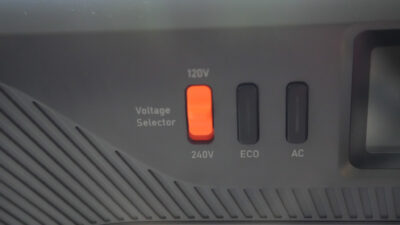
If you want to run heavy appliances like electric stoves or HVAC systems, you’ll want to run multiple units in parallel or use a transfer switch to isolate essential circuits. The Apex 300 supports up to 50A/12,000W bypass capability and 0ms UPS switchover, which means it can handle sudden outages without a hitch.
App Control and Smart Connectivity
One of the most underrated features of the Apex 300 is its seamless integration with the BLUETTI app. From my phone, I can monitor charge levels, adjust output settings, prioritize power sources, and even enable specific modes like Peak Load Shifting or Extreme Weather Alerts. This level of control is crucial when you’re away from home or managing energy use during an outage. The app also pushes firmware updates over the air, which means the system is always improving with new features and optimizations—no tools or tech support required.
Staying Connected: Pairing with Starlink Mini
Power is one thing, but staying connected is another. That’s where the Starlink Mini comes in. I keep mine as part of my go-kit, and the Apex 300 powers it easily. In a blackout, having satellite internet means I can still reach family, check weather alerts, and get work done.
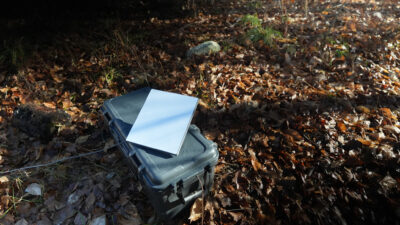
This combo is especially valuable for remote properties. Whether it’s my northern Michigan lease or a hurricane-prone cabin in the Gulf, a backup system is only complete if it keeps you connected. The Apex 300 delivers that.
The Starlink Mini draws on average 40 watts, which means it could power the device for nearly 70 hours on a single charge. Since I won’t be using the Starlink for 70 hours continuously, I could, in theory, provide myself with short bursts of internet connectivity for weeks on end without ever needing to charge the Apex 300.
Everyday Use: Beyond Emergency Power
While the Apex 300 is built to thrive in extreme conditions, it’s equally at home in everyday life. Whether I’m road-tripping across the Midwest or spending long weekends at a remote hunting camp, this power station has quickly become a staple. It’s quiet, clean, and powerful enough to handle whatever I throw at it—from running a portable fridge and charging my tools to lighting up a remote basecamp after dark.
For travel and off-grid use, having reliable power changes everything. I don’t have to worry about draining my vehicle battery or rationing usage when I’m boondocking or off the beaten path. With solar input and expandable storage, the Apex 300 gives me freedom—freedom to stay longer, go further, and remain connected without compromise.
Conclusion
Whether you’re dealing with ice storms in the north or hurricanes on the coast, the need for reliable backup power is universal—and increasingly urgent. The BLUETTI Apex 300 delivers a flexible, high-output solution that fits the unpredictable nature of modern emergencies. Its rapid charge capabilities, expandability with B300K batteries, and versatility across home, RV, and off-grid setups make it one of the most well-rounded power stations available today.
If you’re ready to take the first step toward true energy independence, BLUETTI is currently letting you secure the Apex 300 for just a $10 pre-order deposit on their website. This is an investment that could make a massive difference the next time disaster strikes. Don’t wait for the power to go out—get ahead of it with the Apex 300.





